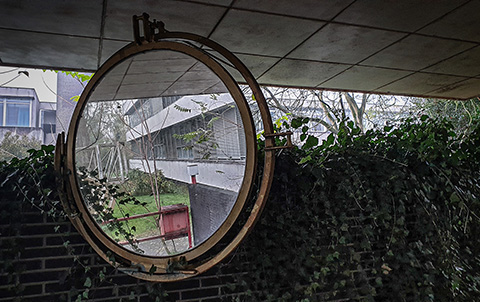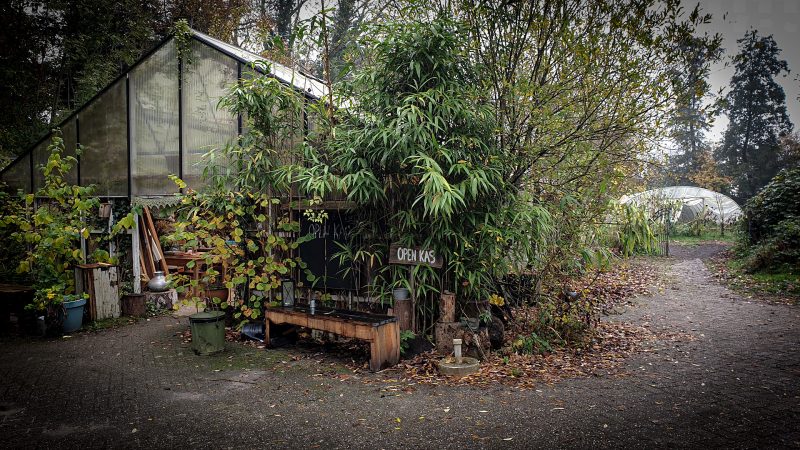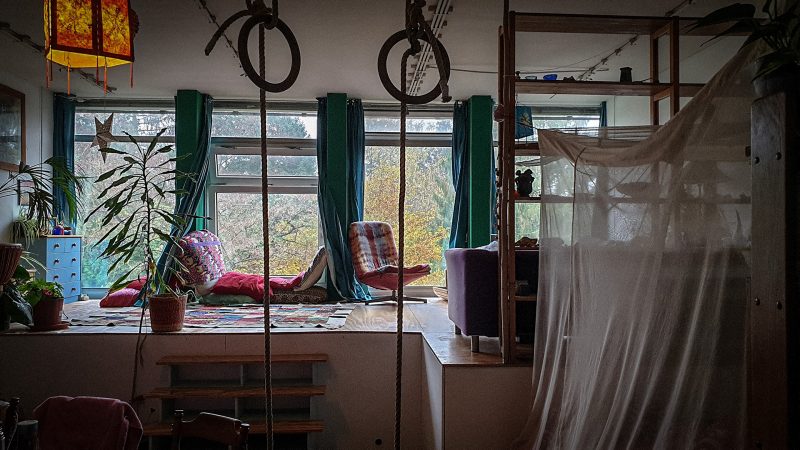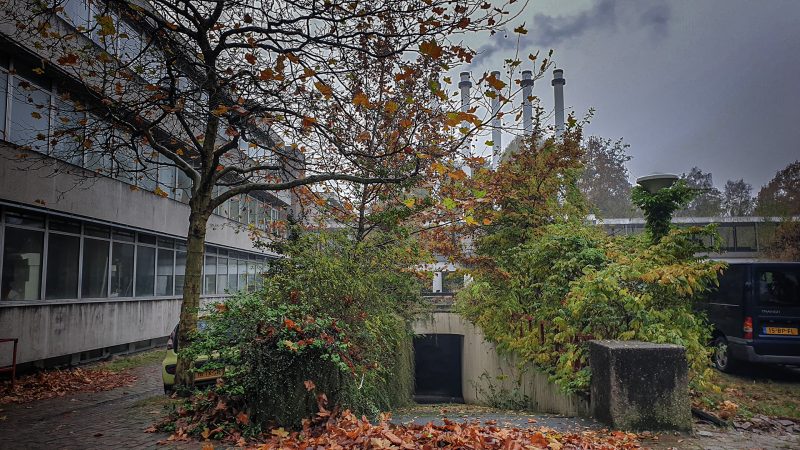
The Hortus is dead, long live the Hortus
A perfect spot near the city
There are brown heaters in every window of the Biotoop, including the thirty or so single-pane windows in the walkways between the buildings. ‘They used to heat the building’, says Judith Brouwer. She attended classes in the Biological Centre back when she studied ecology. Perhaps even in the room she now lives in.
The four windows of her room – ‘the number of windows determines the rental price’ – look out over the picking garden on the south side of the complex. A platform extends from the window, covering the remnants of sinks and worktables. As in most rooms, there’s an old fume hood next to the door, hidden behind an alcove, as it contains asbestos.
It’s not just the fume hoods, though; the entire building is full of asbestos. That’s why a previous attempt at selling the building ten years ago failed. Corporate group Freia felt the old Biological Centre would be a great location to house international students. But cleaning up the building was cost-prohibitive and the complex remained an albatross around the UG’s neck.
Lenze Hofstee, who works at CareX, lived at the former Zoological centre with the Bonobo commune at the time, and had an idea: rent out the complex to artists, small startups, and people who can’t find a place to live anywhere else. The UG agreed and thus, the Biotoop was created.

Surrounding area
These days, the enormous building houses 180 people, including thirty children, a hundred business, and 150 artists. The surrounding area has also been put to use.
‘When we adopted them, they were still bald’, says Judith van Esch, standing in the vegetable garden on the north side of the building. She’s talking about the two former battery chickens that are running around the home-made run together with a rooster they got from a farm. These days, ‘Straight Comb’ and ‘Crooked Comb’ are healthy as a horse. ‘Fresh eggs every day’, says Judith’s friend Rik van den Heuvel, holding up the catch of the day.
In the studio in the basement I can be as loud as I want
Van den Heuvel has been living at the Biotoop for ten years. The musician has a studio in the basement: ‘I can be as loud as I want.’ Van Esch moved in in 2013 and has a studio in one of the business wings. They enjoy living at the complex. They hope that everything works out with the city; they think they’ll be more reasonable than a property developer.
Political parties GroenLinks and the PvdA were also worried that the great plant life at the Hortus and the multicultural nature of the Biotoop would be lost if a property developer got its hands on the complex. They went to the city board with questions and the city and the UG have been talking since spring of this year. No one knows how those talks are going, though. Both parties are keeping mum. The council was supposed to come up with a proposal this month, but that promise had been made and broken before.
‘The best outcome would be if we could keep doing what we’re doing’, says Tjerk Zwanenburg, chair of the Hortus Friends Foundation which financially supports the foundation that manages the botanical garden. ‘For the city to say that even though they own the property, the daily business at the Hortus and the Biotoop is left up to the people, just like it happens now.’

Counterpart
They think the complex could be a counterpart to the developments at the Stadspark and the Suikerunie terrain. ‘The Stadspark is increasingly becoming a hotspot for large events and festivals’, says Zwanenburg. ‘And they’ll be building living units at the Suikerunie.’ He thinks there’s a gap in the market for a creative and social complex and the Biotoop and Hortus can fill that gap. ‘That would also be to the city’s advantage.’
At the picking garden, Irma Frieling is trying to control her puppy. She lives in betwen the greenhouses on the south side of the complex where she holds readings and concerts. ‘They draw all kinds of people’, says Frieling; from wealthy neighbours to refugees. She hopes that everything will work out with the city. ‘I hope it means we can stay here for a few more years and invest in the property.’
The latter is sorely needed. The post-war building doesn’t live up to today’s standards. It has poor isolation and sound travels everywhere. Brouwer took an old cooler door from the basement and attached it to her own door. ‘I need to seal it still, it doesn’t really work yet.’
The radiators in front of the windows switch on all at once to heat an entire wing. They also all switch off at once. In the residential wings, they’re on from eight in the morning until ten at night, while the businesses have heat from eight until five. Former rector magnificus Elmer Sterken called the property a bleeder: the heating costs were enormous. These days, the central heating burns wood pellets, but even that isn’t as environmentally friendly as it was thought to be.

Potential
Fortunately for the UG, the market has since changed. Frans Sijtsma, associate professor of spatial planning, says the property has a lot of potential. ‘It’s really one of the most desirable places to live in the region.’ The property spans four hectares. Taking the national numbers about density and real estate value in Haren, he thinks the property could be worth eighty million euros in house value.
If you use the entire property, you’ll lose out on social value
However, looking at other neighbourhoods in Haren on Google Maps, his calculations come up with a much lower number: twenty to forty million. After all, houses aren’t built that close together.
If takes the price per plot per square metre, probably approximately seven hundred euros, he comes up with a value between fifteen and forty million euros. And that’s just for the four hectares the Biotoop covers. ‘If you use the entire property, it could end up as much more, but then you’ll lose out on social value’, says Sijtsma. But people love attractive green spaces, and research shows they’re willing to pay. Besides, the rest of the property isn’t zoned for residential construction.
The question is how much green space people need, and how much can be used. Perhaps a road or bicycle path between the Rijksstraatweg and the sports fields at the Kerklaan would be nice. Maybe the UMCG would like to expand its rehabilitation centre.
As long as the place hasn’t been sold, nothing is happening, the city board said in a statement. ‘Even when it does, the city wants to maintain the Biotoop and the Hortus Botanicus for a while.’ According to the statement, the UG would like to keep the Laarman garden and the Zoological lab. Other than that, the university and the city aren’t saying anything.
Good outcome
The Hortus Friends hope for a good outcome. The chair points out that more than twenty thousand visitors come to the property each year and that it has three thousand paying members. ‘We’re getting by right now.’ And: ‘If we can be sure that the place will continue to exist in the long term, there are plenty of opportunities to raise extra funds’, says Zwanenburg.
The city will start thinking about what to do with the property in the long term in 2022 and 2023, ‘and even after that, if necessary’. That would mean the residents could stay for at least another two years.
Brouwer doesn’t know what she would do if the place is torn down. ‘I don’t have the money to buy a house.’ She’ll probably find another CareX property to live. But that won’t be easy, especially if all 180 residents are made homeless at once. However, she doesn’t think it will come to that. They wouldn’t kick out everyone at once. ‘They can’t.’
The UG in Haren
1917 Purchase of former estate De Wolff
1920 Botanical garden moves to Haren
1950 Creation of Zoological Lab
1969 Creation of Biological Centre
1986 Hortus gets privatised
2002 Hortus goes bankrupt, UG supports volunteers
2010 Biology department moves to Linnaeusborg, commune moves into Zoological Lab.
2011 Residents move into Biological Centre
2012 Hortus becomes financially independent
2013 Creation of Biotoop
2021 Sale of the entire property?